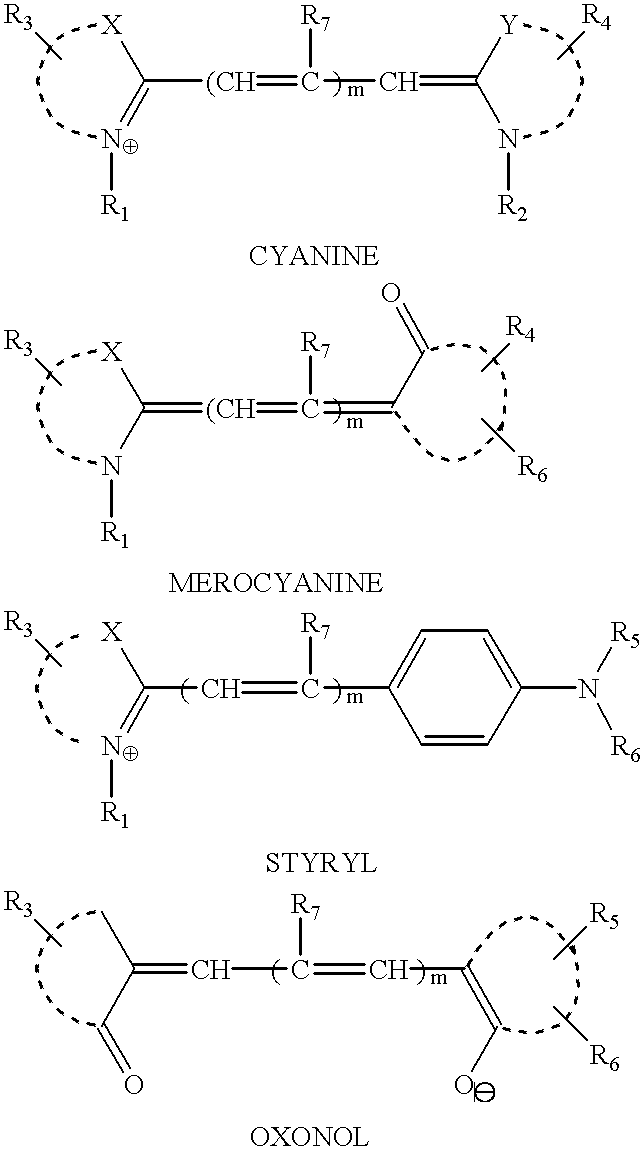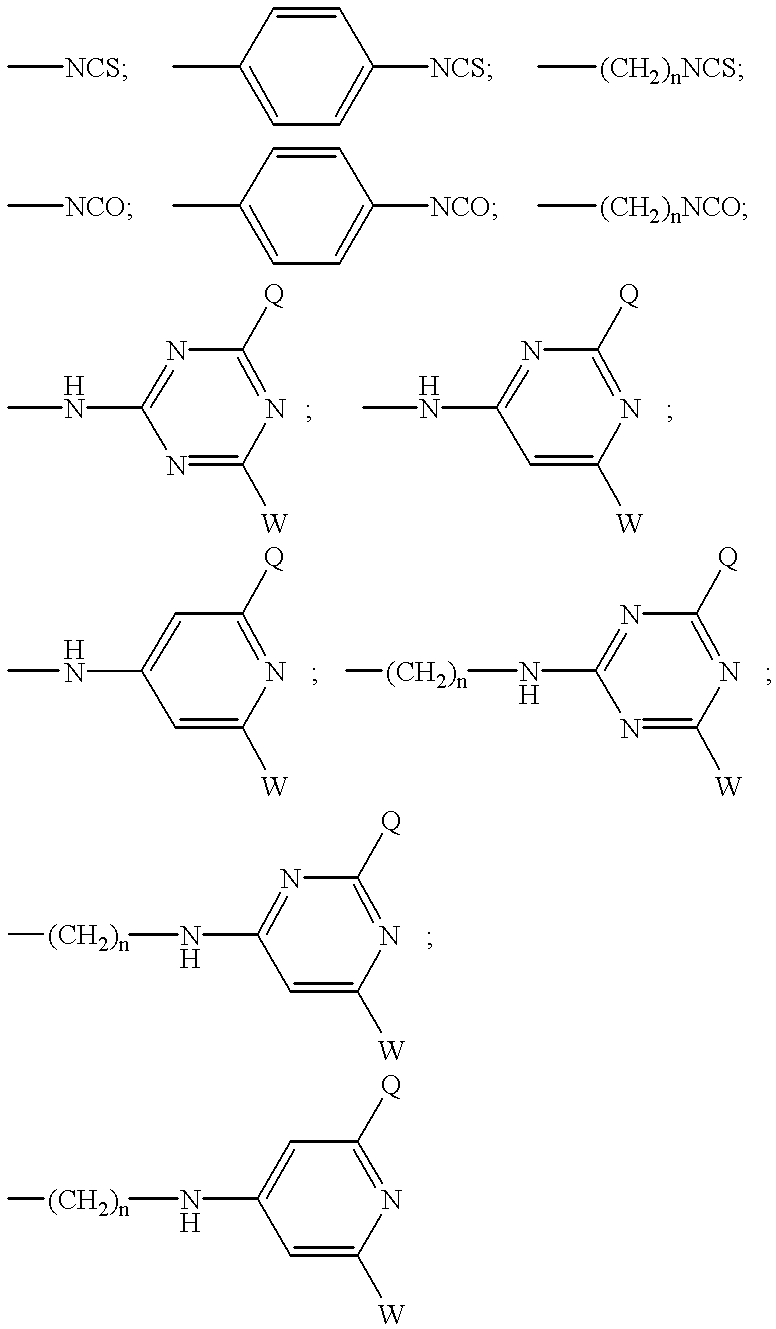Cyanine dyes as labeling reagents for detection of biological and other materials by luminescence methods
a luminescence and labeling technology, applied in the field of cyanine dyes as labeling reagents, can solve the problems of affecting the detection effect, and affecting the accuracy of detection,
- Summary
- Abstract
- Description
- Claims
- Application Information
AI Technical Summary
Problems solved by technology
Method used
Image
Examples
example 1
Reactive dye I:
Anhydro-1-methyl-1'-sulfobutyl-5-N-(3,5-dichloro-2,4 6-triazinyl)-aminomethyl-indodicarbocyanine hydroxide ##STR8##
5-aminomethyl-1,3,3 trimethyl-2-methylene-indolenine (A) was synthesized according to Gale et al., Austr. J. Chem. 30:689-694 (1977). To a solution of 1.0 g cynuric chloride in dry methylene dichloride (40 ml) cooled to -12.degree. C. under nitrogen was added dropwise with stirring a solution of 1.01 g of the aminomethyl-indolenine and 0.7 ml triethylamine in 60 ml methylene dichloride. The resulting brown solution was stirred for 1.5 hr. at 0.degree. C., diluted with 100 ml methylene dichloride and washed with 80 ml water. The light red organic layer was washed with sat. salt solution, dried over sodium sulfate and concentrated to give 1.07 g of a reddish oil, (B).
2,3,3-trimethyl-(3H)-indole (0.48 g) and butane-1, 4-sultone (0.42 g) were heated for three hours in a stoppered flask at 120.degree. C. The viscous semi-solid red mass was cooled, washed with ...
example 2
Reactive dye II:
1-(.gamma.)-isothiocyanatopropyl-1'-methylindocarbocyanine bromide, ##STR9##
2,3,3-trimethyl-(3H)-indole and N-(3-bromo-propyl)phthalimide (2.7 g) were heated at 110.degree. C. in a sealed tube for four hours. The resulting red viscous mass solidified on cooling was washed with ether (2.times.20 ml) and then dried. The 1-(3-phthalimido propyl)-2,3,3-trimethyl indolinium bromide intermediate (C) was crystallized from ethanol-ether.
To produce the second intermediate (D), 2,3,3-trimethyl (3H)-indole (1.6 g) and methyl toluenesulfonate (1.9 g) were heated at 120.degree. C. for 4 hours then cooled to room temperature. To form the cyanine dye intermediate, (E), N,N'-diphenyl formamidine (2 g) and acetic anhydride (25 ml) were added to the solution containing (D) and the mixture was heated with stirring for ten minutes at 110.degree. C. then cooled. To this solution was added an ethanol solution containing intermediate (C). The mixture was heated to complete dissolution, tri...
example 3
Reactive dye III:
Anhydro-1-methyl-1'-(3-sulfopropyl)-5-iodoacetamido-indocarbocyanine hydroxide ##STR10##
The first intermediate, 5-amino-1,3,3 trimethyl-2-methylene-indolenine (F) was prepared according to Gale and Wilshire (1974). The second intermediate, 5-chloroacetamido-1,3,3-trimethyl-2-methylene indolenine (G) was prepared by adding chloroacetylchloride (3.2 ml) in 180 ml dry benzene dropwise with stirring to 1.88 g of (F) in 180 ml dry benzene at 0-50.degree. C. After stirring for 2 hr. more, 100 ml cold water was added. The aqueous layer was separated, made alkaline with ammonium hydroxide and extracted with ether. The ether extract was dried over anhydrous magnesium sulfate and concentrated. Recrystallization of the residue from dichloromethane-hexane (3-10) gave 2 g of yellow crystals, (G), m.p. 128-131.degree. C.
The third intermediate, (H), was formed by the following procedure. A 1.7 g sample of 2,3,3-trimethyl-(3H)-indole and 1.3 g propane-1,3-sultone were heated in a s...
PUM
| Property | Measurement | Unit |
|---|---|---|
| Fraction | aaaaa | aaaaa |
| Fraction | aaaaa | aaaaa |
| Fraction | aaaaa | aaaaa |
Abstract
Description
Claims
Application Information
 Login to View More
Login to View More - R&D
- Intellectual Property
- Life Sciences
- Materials
- Tech Scout
- Unparalleled Data Quality
- Higher Quality Content
- 60% Fewer Hallucinations
Browse by: Latest US Patents, China's latest patents, Technical Efficacy Thesaurus, Application Domain, Technology Topic, Popular Technical Reports.
© 2025 PatSnap. All rights reserved.Legal|Privacy policy|Modern Slavery Act Transparency Statement|Sitemap|About US| Contact US: help@patsnap.com



